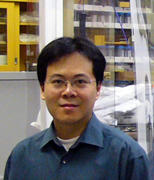
 |
| Friday, April 29, 2011 Meeting |
|---|
| Dr. Jiaxing Huang |  |
|
|
“Graphene Oxide as Colloidal Surfactant: Some New Insights into an Old Material” |
|
Date: April 29, 2011 Location: Colletti’s Dining and Banquets
5707 North Central Avenue
Chicago, IL 60646
773-775-5144
Cost: $30.00 for members of ACS and their guests, $32.00 for non-members, and $15 for students, retired, or unemployedDinner reservations are required and should be received in the Section Office via phone (847-391-9091), email (chicagoacs@ameritech.net), or web by noon on Wednesday, April 27. PLEASE HONOR YOUR RESERVATIONS. The Section must pay for all food orders. No-shows will be billed. Seating will be available for those who wish to attend only the meeting.
Please REGISTER ON LINE
5:30 - 6:30 PM · Job Club
6:00 - 7:00 PM · Social Hour
7:00 - 8:00 PM · Dinner
8:00 PM · General Meeting
Topic: “Graphene oxide as colloidal surfactant: Some new insights into an old material ”
Abstract: Graphite oxide sheet, now named as graphene oxide (GO), is the product of chemical exfoliation of graphite that has been known for more than a century. Interest in this old material has resurged with the rapid development of graphene since 2004, as GO is considered to be a promising precursor for bulk production of graphene. We view GO as an unconventional type of soft material (i.e., polymers, membranes, colloids, liquid crystal and amphiphiles), and aim to establish the assembly-microstructure-properties relationship of these atomically thin sheets.
I will present some new insights into the synthesis, processing, characterization and solution properties of this old material. For example, GO is a known flame retardant for polymers, but it can turn into a serious fire hazard if improperly processed. GO is much more transparent than graphene and therefore even harder to see under optical microscope, but it can be readily visualized by fluorescence quenching microscopy. GO has long been described as hydrophilic due to its ionizable edge functional groups, however, it should be amphiphilic since there are also hydrophobic graphitic nano domains in its basal plane. As the “world’s thinnest bar of soap”, GO shows some intriguing size dependent solution properties, and can act as dispersing agent for insoluble materials in water. Some exciting opportunities and new materials created by this novel sheet-like surfactant, such as a photovoltaic fullerene/nanotube/graphene composite will be presented.
Biography: Jiaxing Huang is an assistant professor in the Department of Materials Science and Engineering at Northwestern University. He received his B.S. degree from the University of Science and Technology (USTC) in China in 2000 and his Ph.D. from the University of California at Los Angeles (UCLA) in 2004. He then was a Miller Research Fellow at the University of California at Berkeley from 2004 to 2007; in 2007 he joined the faculty at Northwestern University.
Huang’s research focuses on creating functional systems by the rational assembly of material building blocks over a broad range of length scales. His research efforts are in four areas: graphene based soft materials; organic nanostructures; metal nanoparticles and in conducting polymer nanostructures for nanotechnology education.
He is widely regarded as one of leaders in research into the chemistry and properties of graphene and has received numerous honors and awards, including: Alfred P. Sloan Research Fellow in 2011; NSF CAREER Award spanning 2010-2015; Miller Research Fellowship from 2004 to 2007 at the University of California at Berkeley; National Starch and Chemical Award from ACS in 2006; MARCO Inventor Recognition Award in 2006; and an IUPAC Prize for Young Chemists in 2005.
Parking: Ample parking in large parking lot, free valet parking, or street parking available.
Dinner:
- Soup of the day
- Garden salad with choice of dressing
- Entrées (choose one):
- chicken marsala
- broiled salmon “Oreganata”
- pasta with vegetables
- Baked potato
- Baby carrots
- Rolls with butter
- Ice cream for dessert
| Last updated 4/4/11 Copyright © 2009-2011, Chicago Section, The American Chemical Society |
Webs by Wizardcraft |